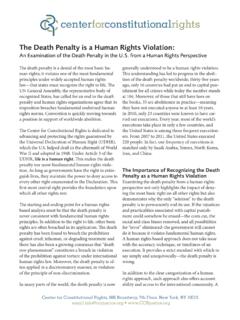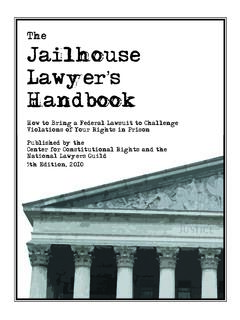Transcription of The Death Penalty is a Human Rights Violation
1 The Death Penalty is a denial of the most basic hu-man Rights ; it violates one of the most fundamental principles under widely accepted Human Rights law that states must recognize the right to life. The UN General Assembly, the representative body of recognized States, has called for an end to the Death Penalty and Human Rights organizations agree that its imposition breaches fundamental enshrined Human Rights norms. Convention is quickly moving towards a position in support of worldwide Center for Constitutional Rights is dedicated to advancing and protecting the Rights guaranteed by the Universal Declaration of Human Right (UDHR), which the helped draft in the aftermath of World War II and adopted in 1948. Under Article 3 of the UDHR, life is a Human right. This makes the Death Penalty our most fundamental Human Rights viola-tion. As long as governments have the right to extin-guish lives, they maintain the power to deny access to every other right enumerated in the Declaration.
2 This first most central right provides the foundation upon which all other Rights starting and ending point for a Human Rights based analysis must be that the Death Penalty is never consistent with fundamental Human Rights principles. In addition to the right to life, other basic Rights are often breached in its application. The Death Penalty has been found to breach the prohibition against cruel, inhuman, or degrading treatment and there has also been a growing consensus that Death row phenomenon constitutes a breach in Violation of the prohibition against torture under international Human Rights law. Moreover, the Death Penalty is of-ten applied in a discriminatory manner, in Violation of the principle of many parts of the world, the Death Penalty is now generally understood to be a Human Rights Violation . This understanding has led to progress in the aboli-tion of the Death Penalty worldwide; thirty-five years ago, only 16 countries had put an end to capital pun-ishment for all crimes while today the number stands at 104.
3 Moreover, of those that still have laws on the books, 35 are abolitionist in practice meaning they have not executed anyone in at least 10 years. In 2010, only 23 countries were known to have car-ried out executions. Every year, most of the world s executions take place in only a few countries, and the United States is among those frequent execution-ers. From 2007 to 2011, the United States executed 220 people. In fact, our frequency of executions is matched only by Saudi Arabia, Yemen, North Korea, Iran, and Importance of Recognizing the Death Penalty as a Human Rights ViolationExamining the Death Penalty from a Human Rights perspective not only highlights the impact of deny-ing the most basic right on all other Rights but also demonstrates why the only solution to the Death Penalty is to permanently end its use. If the injustices and practicalities associated with capital punish-ment could somehow be erased the costs cut, the racial and class biases removed, and all possibilities for error eliminated the government still cannot do it because it violates fundamental Human Rights .
4 A Human Rights based approach does not take issue with the accuracy, technique, or timeliness of an execution. It provides a strict standard with which to say simply and unequivocally the Death Penalty is wrong. In addition to the clear categorization of a Human Rights approach, such approach also offers account-ability and access to the international community. A Center for Constitutional Rights , 666 Broadway, 7th Floor, New York, NY 10012 email Death Penalty is a Human Rights Violation :An Examination of the Death Penalty in the from a Human Rights Perspectivehuman Rights approach obligates duty bearers (usu-ally States) to: 1) respect; 2) protect; and 3) fulfill Human Rights . In the context of the Death Penalty , this means not depriving the fundamental Human Rights such as life of those sentenced to crimes; taking positive steps to ensure the Human Rights of the accused and sentenced; and adopting national legislation to achieve full realization of the Rights of these October 10, 2011, CCR joined the world in com-memorating the 9th Annual World Day Against the Death Penalty , by issuing a position paper entitled, The US Tortures Before it Kills: An Examination of the Death Row Experience from a Human Rights Perspec-tive, which analyzes life on Death row including decades in solitary confinement with limited Human contact, and the intolerable process of repeatedly coming within hours of execution as torture under international Human Rights law.
5 According to the Convention Against Torture (CAT), a treaty rati-fied by the US in 1994, torture is defined, in part, as any act by which severe pain or suffering, whether physical or mental, is inflicted on a person for such purposes as [..] punishing him for an act he [..] has committed or is suspected of having committed. Torture is a crime against humanity, a war crime, and a Violation of the Geneva Conventions, as reflected in the statutes of the International Criminal Court, the International Criminal Tribunal for the former Yugoslavia, and the International Criminal Tribunal for Rwanda, among other judicial authorities. Over the last 15 years, a substantial body of law has de-veloped that sets forth the elements of torture under customary international law, which largely reflects the definition of torture under the CAT. Torture has been found to be a Violation of personal dignity and is used for such purposes as intimidation, degrada-tion, humiliation and discrimination, punishment, control or destruction of a person.
6 It has been shown that humans experience isolation as torture. Decades in isolation without access to family, other prisoners, programming, or any other form of intellectual or social stimulation, along with the constant knowledge of one s impending, but uncertain Death , combine to create the Death row phenomenon. The UN Special Rapporteur on Torture, Juan M ndez, has recently called for the prohibition of solitary confinement and in August 2011 issued a report on this practice amounting to Death Penalty in the United StatesIn addition to violating the right to life, critics have argued that capital punishment, as it is applied in the United States, is expensive, racist, arbitrary, and fal-lible. Further, the deterrent effect of the Death pen-alty has never been proven. Decades of experience have confirmed that capital punishment in the US is not only a fundamental Human Rights Violation , but is also fundamentally flawed in design and imple-mentation.
7 Additionally, prisoners in the US spend decades on Death row in dehumanizing conditions which amount to torture under international putting people to Death has not been a con-stant practice in the United States; from 1967-1977 executions were halted across the US. However, cur-rently, approximately 3,300 people still await execu-tion in the United States. 34 states are still retention-ist, meaning they have Death Penalty laws on the books. People of color have accounted for a disproportion-ate 43% of total executions since 1976 and 55% of those currently awaiting execution while they only account for approximately 27% of the general popu-lation. The Death Penalty , as applied, has been found to violate the non-discrimination requirement found in international Human Rights law. Two treaties which the has ratified, the International Convention on the Elimination of All Forms of Racial Discrimi-nation (ICERD) and the International Covenant on Civil and Political Rights (ICCPR) ensure the right to non-discrimination.
8 In 2006, the UN Human Rights Committee recommended that the assess the extent to which [the] Death Penalty is disproportion-ately imposed on ethnic minorities and on low-income population groups, as well as the reasons for this, and adopt all appropriate measures to address the problem. Center for Constitutional Rights , 666 Broadway, 7th Floor, New York, NY 10012 email the last decade, some progress has been made against the Death Penalty in the US, yet there is still much to be done. In the 2002 Atkins v. Virginia Supreme Court deci-sion, the court found that executing the mentally disabled constitutes cruel and unusual punishment. This decision, however, has left it to the states to determine how to apply this constitutional restric-tion, resulting in a standard in some states that is hard to meet, and thus, results in the ongoing prac-tice of executing the mentally ill.
9 As a result, the US continues to violate international Human Rights law (CAT and the ICCPR) in this respect, despite the fact that the UN Commission on Human Rights has called for states to refrain from executing any-one with any form of mental disorder. In 2005, the Supreme Court overturned the ju-venile Death Penalty in Roper v. Simmons. In this case, the Court cited international Human Rights law in their decision, including the ICCPR and the 1989 Convention on the Rights of the Child (CRC), which prohibits the imposition of capital punishment on persons below 18 years of age. The CRC, ratified by 193 countries, is the most widely accepted Human Rights treaty in history. The is one of only three countries which have not ratified the CRC; the others are Somalia and South Sudan. Some states have made progress recently with pass-ing legislation abolishing the Death Penalty .
10 Illinois is the most recent state to abolish the Death Penalty (2011). In other states, there have been executive decisions to stop executions. For example, on No-vember 11, 2011 the Governor of Oregon put a stay on executions [b]oth because of [his] own deep personal convictions about capital punishment and also because in practice, Oregon has an expensive and unworkable system that fails to meet basic standards of justice. On September 28, 2011, charges were brought in the first Death Penalty case that will be tried at the US military commissions at Guant namo Bay, Cuba. These military commissions are unlawful, unconsti-tutional, and a perversion of justice. Seeking to ex-ecute people based on a system that allows evidence obtained through torture, secrecy, hearsay evidence, and has considerably low standards for proving guilt is not only illegal, but also morally reprehensible.
















